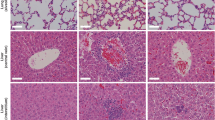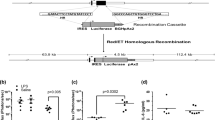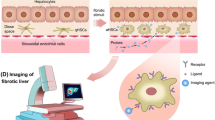Abstract
Objective
To monitor the inflammatory storage lesions of end-stage stored whole blood (SWB) using a noninvasive STAT3 signal pathway mouse model.
Results
In this study, we present a hydrodynamic transfection-based STAT3-Luc mouse model in which hepatocyte STAT3 signal pathway activation can be monitored by measuring luciferase activity using a noninvasive imaging system. Such a mouse model may reflect systemic IL-6 and inflammation levels by monitoring the activation of STAT3. During end-stage SWB transfusion, in vivo imaging of STAT3-Luc mice showed obvious luciferase activity in the hepatic region, which was consistent with an increase in IL-6 levels in the liver homogenate and circulation. We also confirmed that the mononuclear phagocytic system contributed to the elevation of serum and liver IL-6 after end-stage SWB transfusion.
Conclusion
The hepatocyte STAT3 signaling pathway, which is activated by end-stage SWB transfusion, is associated with the elevation of systemic IL-6 secreted by macrophages. The STAT3-Luc mouse may serve as a mouse model for monitoring inflammation responses after end-stage SWB transfusion.







Similar content being viewed by others
References
Badr CE, Tannous BA (2011) Bioluminescence imaging: progress and applications. Trends Biotechnol 29:624–633
Contag CH, Jenkins D, Contag PR, Negrin RS (2000) Use of reporter genes for optical measurements of neoplastic disease in vivo. Neoplasia 2:41–52
Daniel Y, Sailliol A, Pouget T, Peyrefitte S, Ausset S, Martinaud C (2017) Whole blood transfusion closest to the point-of-injury during French remote military operations. J Trauma Acute Care Surg 82:1
Elster EA, Bailey J (2017) Prehospital blood transfusion for combat casualties. JAMA 318:1548–1549
Emery P et al (2008) IL-6 receptor inhibition with tocilizumab improves treatment outcomes in patients with rheumatoid arthritis refractory to anti-tumour necrosis factor biologicals: results from a 24-week multicentre randomised placebo-controlled trial. Ann Rheum Dis 67:1516–1523
Gang N et al (2013) Longitudinal bioluminescence imaging of the dynamics of Doxorubicin induced apoptosis. Theranostics 3:190–200
Garcíaroa M et al (2017) Red blood cell storage time and transfusion: current practice, concerns and future perspectives. Blood Transfus 15:222
Greenbaum BH (1991) Transfusion-associated graft-versus-host disease: historical perspectives, incidence, and current use of irradiated blood products. J Clin Oncol 9:1889–1902
Gurney JM, Spinella PC (2018) Blood transfusion management in the severely bleeding military patient. Curr Opin Anaesthesiol 31:207
Harvey AR, Basavaraju SV, Chung KW, Kuehnert MJ (2015) Transfusion-related adverse reactions reported to the National Healthcare Safety Network Hemovigilance Module, United States, 2010 to 2012. Transfusion 55:709–718
Hergenroeder GW, Moore AN, McCoy JP, Samsel L, Iii NHW, Clifton GL, Dash PK (2010) Serum IL-6: a candidate biomarker for intracranial pressure elevation following isolated traumatic brain injury. J Neuroinflamm 7(1):19
Hess JR, Greenwalt TG (2002) Storage of red blood cells: new approaches. Transfus Med Rev 16:283–295
Higuchi N et al (2003) Hydrodynamics-based delivery of the viral interleukin-10 gene suppresses experimental crescentic glomerulonephritis in Wistar-Kyoto rats. Gene Therapy 10:1297–1310
Hod EA et al (2010) Transfusion of red blood cells after prolonged storage produces harmful effects that are mediated by iron and inflammation. Blood 115:4284–4292
Holcomb JB, Jenkins DH (2018) Get ready: whole blood is back and it’s good for patients. Transfusion 58:1821–1823
Knutson M, Wessling-Resnick M (2003) Iron Metabolism in the Reticuloendothelial System Crc. Crit Rev Biochem 38:61–88
Nam-Hoon K, Mun-Yong L, Seon-Joo P, Jeong-Sun C, Mi-Kyung O, In-Sook K (2010) Auranofin blocks interleukin-6 signalling by inhibiting phosphorylation of JAK1 and STAT3. Immunology 122:607–614
Ning Z, Aneil W, Bonnie L, Richard L, Contag PR, Purchio AF, West DB (2003) An inducible nitric oxide synthase-luciferase reporter system for in vivo testing of anti-inflammatory compounds in transgenic mice. J Immunol 170:6307
Ning Z, Ahsan MH, Purchio AF, West DB (2005) Serum amyloid A-luciferase transgenic mice: response to sepsis, acute arthritis, and contact hypersensitivity and the effects of proteasome inhibition. J Immunol 174:8125–8134
Park E et al (2010) Dietary and genetic obesity promote liver inflammation and tumorigenesis by enhancing IL-6 and TNF. Expr Cell 140:197–208
Shackelford SA et al (2017) Association of prehospital blood product transfusion during medical evacuation of combat casualties in afghanistan with acute and 30-day survival. JAMA 318:1581
Theurl I et al (2016) On-demand erythrocyte disposal and iron recycling requires transient macrophages in the liver. Nat Med 22(8):945–951
Vlaar APJ, Juffermans NP (2013) Transfusion-related acute lung injury: a clinical review. Lancet 382:984–994
Woodard HQ, White DR (1986) The composition of body tissues. Br J Radiol 59:1209
Wu T et al (2017) Noninvasive imaging of stored red blood cell-transfusion aggravating sepsis-induced liver injury associated with increased activation of M1-polarized Kupffer cells. Shock 48(4):459–466
Xia S et al (2016) Sodium pyruvate improves the storage damage of red blood cells Chinese. J Blood Transfus 29:353–356
Yan S et al (2013) Establishment of stable reporter expression for in vivo imaging of nuclear factor-κB activation in mouse liver. Theranostics 3:841–850
Yazer MH, Cap AP, Spinella PC, Alarcon L, Triulzi DJ (2018) How do I implement a whole blood program for massively bleeding patients? Transfusion 58(3):622–628
Yong Z et al (2012) Noninvasive molecular imaging of interferon beta activation in mouse liver. Liver Int 32:383–391
Zhang W, Feng JQ, Harris SE, Contag PR, Stevenson DK, Contag CH (2001) Rapid in vivo functional analysis of transgenes in mice using whole body imaging of luciferase expression. Transgenic Res 10:423–434
Zhang Y et al (2016) Non-invasive imaging serum amyloid A activation through the NF-κB signal pathway upon gold nanostructure exposure. Small 12:3270–3282
Acknowledgements
This work was supported by Foundation of AHJ17J002-06, the National Natural Science Foundation of China (81800183) and the Mega-Project of Science Research (2017ZX10304402-003-004, 2017ZX10304402-003-011).
Author information
Authors and Affiliations
Corresponding authors
Ethics declarations
Conflict of interest
The authors declare that they have no conflict of interest.
Additional information
Publisher's Note
Springer Nature remains neutral with regard to jurisdictional claims in published maps and institutional affiliations.
Rights and permissions
About this article
Cite this article
Wang, Z., Zhang, Y., Zhou, Q. et al. Noninvasive imaging of hepatocyte IL-6/STAT3 signaling pathway for evaluating inflammation responses induced by end-stage stored whole blood transfusion. Biotechnol Lett 41, 733–742 (2019). https://doi.org/10.1007/s10529-019-02688-0
Received:
Accepted:
Published:
Issue Date:
DOI: https://doi.org/10.1007/s10529-019-02688-0




